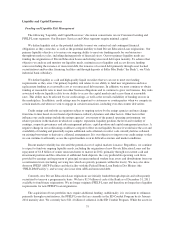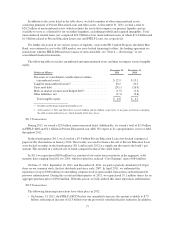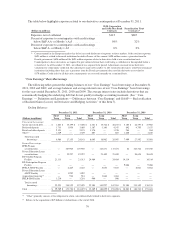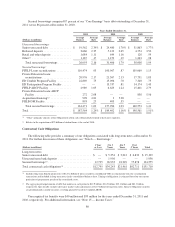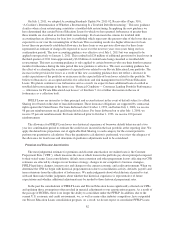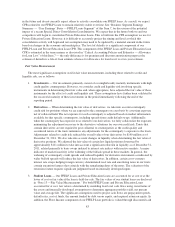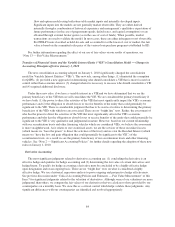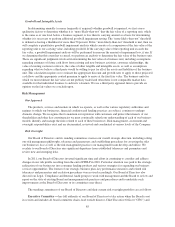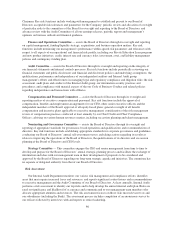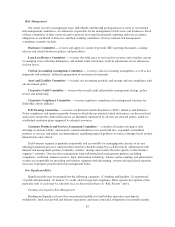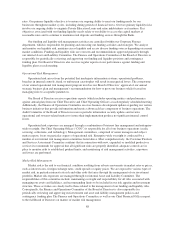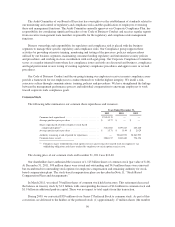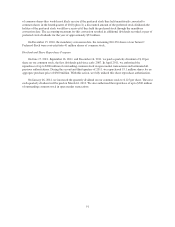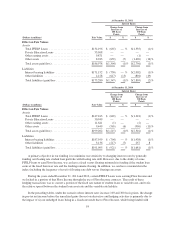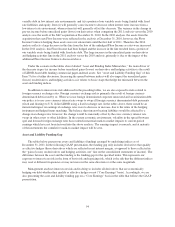Sallie Mae 2011 Annual Report Download - page 86
Download and view the complete annual report
Please find page 86 of the 2011 Sallie Mae annual report below. You can navigate through the pages in the report by either clicking on the pages listed below, or by using the keyword search tool below to find specific information within the annual report.flow and option models using both observable market inputs and internally developed inputs.
Significant inputs into the models are not generally market observable. They are either derived
internally through a combination of historical experience and management’s qualitative expectation of
future performance (in the case of prepayment speeds, default rates, and capital assumptions) or are
obtained through external broker quotes (as in the case of cost of funds). When possible, market
transactions are used to validate the model. In most cases, these are either infrequent or not observable.
For FFELP Loans classified as held-for-sale and accounted for at the lower of cost or market, the fair
value is based on the committed sales price of the various loan purchase programs established by ED.
For further information regarding the effect of our use of fair values on our results of operations, see
“Note 13 — Fair Value Measurements.”
Transfers of Financial Assets and the Variable Interest Entity (“VIE”) Consolidation Model — Changes in
Accounting Principles effective January 1, 2010
The new consolidation accounting adopted on January 1, 2010 significantly changed the consolidation
model for Variable Interest Entities (“VIEs”). This new rule, among other things, (1) eliminated the exemption
for QSPEs, (2) provided a new approach for determining who should consolidate a VIE that is more focused on
control rather than economic interest, (3) changed when it is necessary to reassess who should consolidate a VIE
and (4) required additional disclosure.
Under these new rules, if we have a variable interest in a VIE and we have determined that we are the
primary beneficiary of the VIE then we will consolidate the VIE. We are considered the primary beneficiary if
we have both: (1) the power to direct the activities of the VIE that most significantly impact the VIE’s economic
performance and (2) the obligation to absorb losses or receive benefits of the entity that could potentially be
significant to the VIE. There is considerable judgment that has to be used as it relates to determining the primary
beneficiary of the VIEs with which we are associated. There are no “bright line” tests. Rather, the assessment of
who has the power to direct the activities of the VIE that most significantly affects the VIE’s economic
performance and who has the obligation to absorb losses or receive benefits of the entity that could potentially be
significant to the VIE is very qualitative and judgmental in nature. However, based on our current relationship
with our securitization trusts and other financing vehicles which are considered VIEs, we believe the assessment
is more straightforward. As it relates to our securitized assets, we are the servicer of those securitized assets
(which means we “have the power” to direct the activities of the trust) and we own the Residual Interest (which
means we “have the loss and gain obligation that could potentially be significant to the VIE”) of the
securitization trusts. As a result we are the primary beneficiary of our securitization trusts and other financing
vehicles. See “Note 2 — Significant Accounting Policies” for further details regarding the adoption of these new
rules on January 1, 2010.
Derivative Accounting
The most significant judgments related to derivative accounting are: (1) concluding the derivative is an
effective hedge and qualifies for hedge accounting and (2) determining the fair value of certain derivatives and
hedged items. To qualify for hedge accounting a derivative must be concluded to be a highly effective hedge
upon designation and on an ongoing basis. There are no “bright line” tests on what is considered a highly
effective hedge. We use a historical regression analysis to prove ongoing and prospective hedge effectiveness.
See previous discussion under “Critical Accounting Policies and Estimates — Fair Value Measurement” of this
Item 7 for significant judgments related to the valuation of derivatives. Although some of our valuations are more
judgmental than others, we compare the fair values of our derivatives that we calculate to those provided by our
counterparties on a monthly basis. We view this as a critical control which helps validate these judgments. Any
significant differences with our counterparties are identified and resolved appropriately.
84



